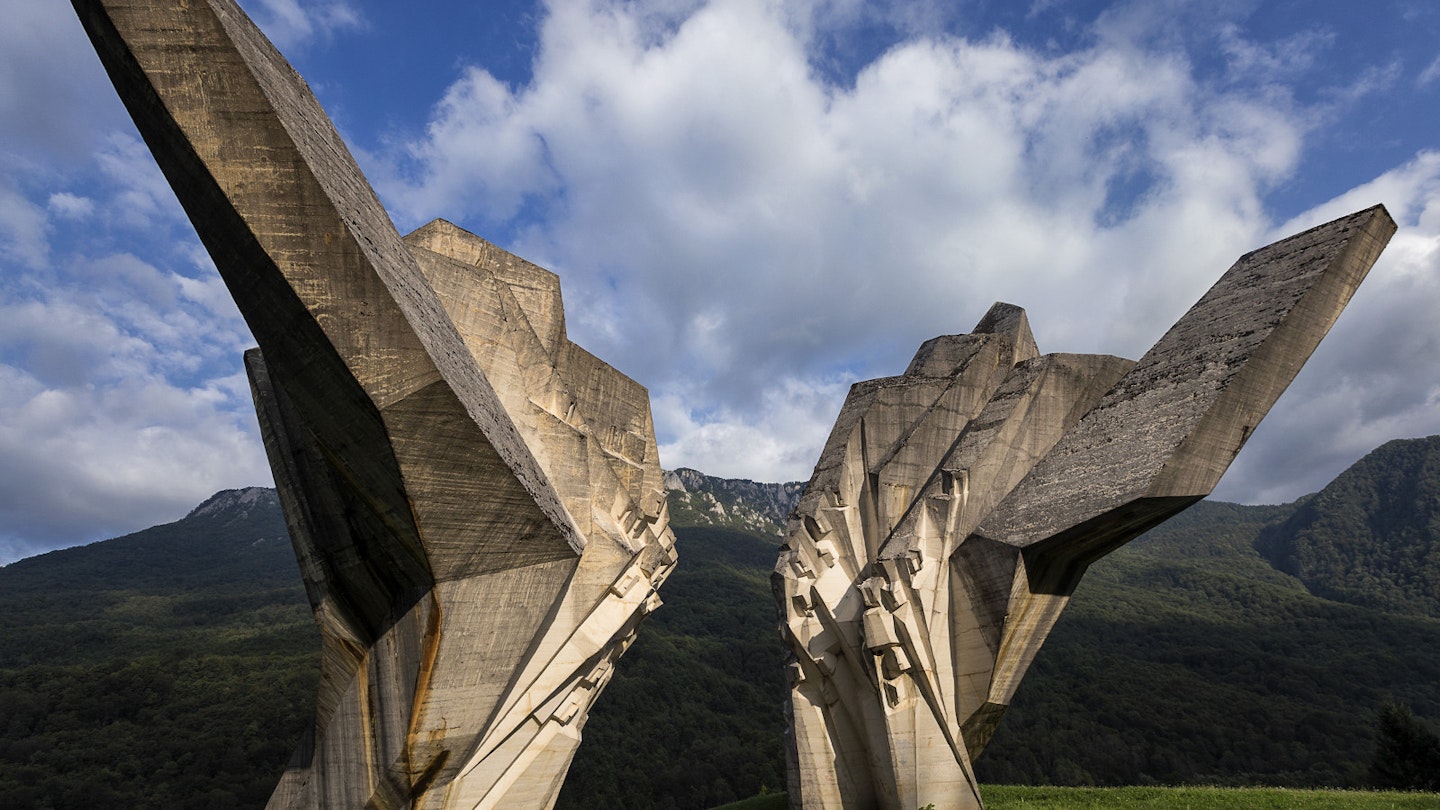Every year, an increasing number of travellers embark on journeys to the Balkans to explore the captivating countries that once made up the former Yugoslavia. Some travellers seek adventure, while many are drawn by the rich history and diverse culture, and others are enchanted by the region’s fresh cuisine and breathtaking landscapes. A trip to witness some of the world’s most innovative monumental artwork fulfills every desire.

The sculptures and monuments designed by Serbian architect Bogdan Bogdanović (1922–2010) stand as testaments to Yugoslavia’s vibrant history and innovative public art. His monumental works, often comparable in size to buildings, were created over three decades from the 1950s to the late 1980s and emerge dramatically from seemingly forgotten landscapes. Constructed from polished concrete, steel, stone, and wood, these imposing structures take the form of cones, sci-fi flowers, wings, horns, fountains, and columns, commemorating the region’s complex 20th-century history, ethnic diversity, war, antifascist resistance, and ideological unity. Over 20 remarkable works by Bogdanović continue to grace the landscape of the former country.

Although Bogdanović was one of numerous architects committed to the creation of hundreds of significant memorials throughout the post-WWII period in the now-defunct Socialist Federal Republic of Yugoslavia, his innovative works have gained international prominence. These grand installations not only showcase modernist design but also successfully navigate the prevailing style of Socialist Realism of that era. His artistic expressions are found throughout the former Yugoslav republics (with the notable absence of Slovenia) and in contemporary Kosovo, often situated near former battlefields and significant historical sites. As tourism in the Balkans has increased, these monumental public art pieces are inspiring a new generation of visitors, fostering engagement with projects like the Spomenik Database, which aims to document and interpret these monumental legacies.

The architect’s most iconic structure is the nearly 24m high Stone Flower in Jasenovac, Croatia. Completed in 1966, this striking monument, reminiscent of a bird, commemorates the victims of WWII concentration camps. In Belgrade, the Monument to the Jewish Victims of Fascism, featuring 10.5m wings, honors the victims in the Sephardic cemetery and was constructed in 1952. Additionally, the Shrine to the Revolution in Kosovska Mitrovica, Kosovo, a 19m memorial symbolically showcases two columns supporting a mining cart to pay homage to Serbian and Albanian miners who united against German forces during WWII.
‘I have a particular admiration for two aspects of Bogdanović’s work: his focus on the entire process of creating monuments and his efforts to address the challenges related to ethnic and religious conflicts in the region,’ remarks Sanja Horvatinčić, a postdoctoral researcher at the Institute of Art History in Zagreb, Croatia. She highlights how he collaborated with local craftsmen – from stonemasons to shipbuilders – using their skills in the monument’s construction. Furthermore, his insistence on involving the local community in the monument-building process fostered a sense of belonging and heritage.

More than 25 years after the dissolution of Yugoslavia, the architecture and artistic creations of figures like Bogdanović are reaffirming the region’s significance as a bridge between the capitalist West and the communist East during the Cold War. In 2018, the Museum of Modern Art (MoMA) in New York City will showcase Yugoslavia’s design heritage through an exhibition titled ‘Toward a Concrete Utopia: Architecture in Yugoslavia, 1948–1980.’ This exhibition, running from July 15, 2018, to January 13, 2019, will delve into themes such as urbanization, technological progress, consumerism, and the role of monuments in memorialization.
‘We have identified four key figures within Yugoslav architectural culture, each of whom has significantly influenced the country through both their buildings and their wider roles as public intellectuals and educators. Bogdan Bogdanović is one of these pivotal figures,’ states Martino Stierli, MoMA’s Philip Johnson Chief Curator of Architecture and Design. He notes that Yugoslavia possessed a rich and diverse legacy of modern architectural innovation. ‘During the Cold War, socialist Yugoslavia aimed to promote a “third way” between the two dominant world orders, fostering a unique openness to experimentation and even utopian ideals in architecture.’

For the growing number of travellers journeying through the seven independent nations that emerged from Yugoslavia, a revitalized fascination with the Balkans’ rich cultural heritage offers yet another compelling reason to visit. Not only will they gain a deeper understanding of its shared history, but they can also experience its most unique regions—from the sun-kissed Dalmatian coastline to the rugged Dinaric Alps and the flat plains of the Vojvodina province. Key monuments include Tjentište in Sutjeska National Park, Bosnia & Hercegovina; Podgarić, near the Croatian capital of Zagreb; the magnificent Kadinjača near Tara National Park, Serbia; and the Ilinden monument in the town of Kruševo, North Macedonia.
According to Vjeran Pavlaković, an associate professor of cultural studies at the University of Rijeka, ‘By the late socialist period, the Yugoslav regime constructed many memorials within nature parks to revitalize underdeveloped regions. Consequently, many of these monuments are placed in stunning locations.’ He further notes that recent years have seen all countries in the region recognizing the importance of investing in cultural heritage. The journey to discover these monuments enhances the travel experience, encouraging visitors to venture off the beaten path, engage with locals, and savor traditional food and drink, all while immersing themselves in the extraordinary architectural artistry of a once-united nation.





